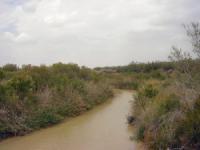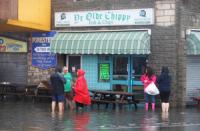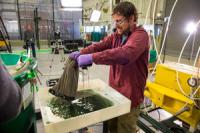-
Roll, Jordan, Roll? -- Where the Jordan River stops flowing

A new study argues that Israel’s Jordan River may be a useful case study for the challenges facing stream restoration initiatives around the world. The Jordan River has been ravaged by unbridled population growth and defunct sewage treatment plants, and the river now has only 3 percent of its original flow. “No river enjoys better PR and has worse environmental conditions than the Jordan River,” says a researcher.
-
-
U.K. airports, nuclear power stations on terror alert following “credible” threat
Airports and nuclear power stations in the United Kingdom have been instructed to bolster their defenses against terrorist attacks in the face of intensified threats to electronic security systems. Security services have issued a series of alerts over the weekend, warning that terrorists may have developed ways of bypassing safety checks. U.S. and British security services are concerned that terrorists will use the techniques they developed to bypass screening devices at European and U.S. airports, against other critical infrastructure facilities such as nuclear power stations.
-
-
11 percent of disappearing groundwater used to grow internationally traded food

Wheat, rice, sugar, cotton and maize are among the essential internationally traded crops in the global economy. To produce these crops, many countries rely on irrigated agriculture that accounts for about 70 percent of global freshwater withdrawals, according to the United Nations Water program. One freshwater source is underground aquifers, some of which replenish so slowly that they are essentially a non-renewable resource.
-
-
Managed retreat: Relocating communities to get them out of harm’s way
More frequent extreme weather events put certain regions in the cross hairs of risks such as coastal flooding, heavy rain, and erosion. There is an obvious, but controversial, solution: relocating communities from vulnerable to safer areas. Based on examples from around the world, researchers chart the landscape for whether and how to implement the strategy of managed retreat – and how, with the minimum disruption possible, relocate or abandon development in the face of extreme weather risks.
-
-
Sea level rise makes much of Honolulu and Waikiki groundwater vulnerable to inundation
Researchers found that a large part of the heavily urbanized area of Honolulu and Waikīkī is at risk of groundwater inundation — flooding that occurs as groundwater is lifted above the ground surface due to sea level rise. “Our findings suggest that coastal communities in Hawai’i and globally are exposed to complex groundwater flooding hazards associated with sea level rise in addition to the typical concerns of coastal erosion and wave overtopping,” said one researchers. “Groundwater inundation will require entirely unique adaptation methods if we are to continue to live in and develop the coastal zone. Coastal planners and community stakeholders will need to work with architects, engineers, geologists, ecologists, economists, hydrologists and other innovative thinkers in order to manage these problems.”
-
-
Carbon Law, modeled after Moore’s Law, a pathway to halve emissions every decade

Moore’s Law states that computer processors double in power about every two years. While it is neither a natural nor legal law, this simple rule of thumb or heuristic has been described as a golden rule which has held for fifty years and still drives disruptive innovation. Research say that a carbon roadmap, driven by a simple rule of thumb, or Carbon Law, of halving emissions every decade, could catalyze disruptive innovation. Following a Carbon Law, which is based on published energy scenarios, would give the world a 75 percent chance of keeping Earth below 2°C above pre-industrial temperatures, the target agreed by nations in Paris in 2015.
-
-
Past quakes at Calif. fault portend abrupt sinking of Seal Beach wetlands
A new study shows evidence of abrupt sinking of the wetlands near Seal Beach caused by ancient earthquakes that shook the area at least three times in the past 2,000 years — and it could happen again, the researchers say. The paleoseismology study reveals that the wetlands at the National Wildlife Refuge Seal Beach, a nearly 500-acre area located within the Naval Weapons Station Seal Beach and next to the communities of Seal Beach and Huntington Harbor, are susceptible to rapid lowering in elevation during large — over 7.0 magnitude earthquakes.
-
-
Nextgen robots for nuclear clean-up

The cost of cleaning up the U.K.’s existing nuclear facilities has been estimated to be between £95 billion, and £219 billion over the next 120 years or so. The harsh conditions within these facilities means that human access is highly restricted and much of the work will need to be completed by robots. Present robotics technology is simply not capable of completing many of the tasks that will be required. A research a consortium to build the next generation of robots that are more durable and perceptive for use in nuclear sites.
-
-
The old, dirty, creaky U.S. electric grid would cost $5 trillion to replace. Where should infrastructure spending go?

The electric grid is an amazing integrated system of machines spanning an entire continent. The National Academy of Engineering has called it one of the greatest engineering achievements of the twentieth century. But it is also expensive. By my analysis, the current (depreciated) value of the U.S. electric grid, comprising power plants, wires, transformers and poles, is roughly $1.5 to $2 trillion. To replace it would cost almost $5 trillion. That means the U.S. electric infrastructure, which already contains trillions of dollars of sunk capital, will soon need significant ongoing investment just to keep things the way they are. There is no path toward shoring up or upgrading the U.S. electric grid that does not require investment – even just maintaining what we have will cost hundreds of billions, if not trillions, of dollars over the next decade. The bigger question is: As we continue to replace and rebuild this amazing grid, what technologies should we focus on?
-
-
EPA awards $100 million to Michigan for Flint water infrastructure upgrades
The U.S. Environmental Protection Agency (EPA) last week awarded a $100 million grant to the Michigan Department of Environmental Quality to fund drinking water infrastructure upgrades in Flint, Michigan. The funding, provided by the Water Infrastructure Improvements for the Nation Act of 2016, or WIIN, enables Flint to accelerate and expand its work to replace lead service lines and make other critical infrastructure improvements.
-
-
Extreme sea levels could endanger European coastal communities

Massive coastal flooding in northern Europe that now occurs once every century could happen every year if greenhouse gas emissions continue to rise, according to a new study. New projections considering changes in sea level rise, tides, waves and storm surge over the twenty-first century find global warming could cause extreme sea levels to increase significantly along Europe’s coasts by 2100. Extreme sea levels are the maximum levels of the sea that occur during a major storm and produce massive flooding.
-
-
Map shows seawater threat to California Central Coast aquifers
More than half the world’s population lives within 37 miles (60 kilometers) of the coast, and three-quarters of all large cities are located in coastal areas. Many coastal communities rely on groundwater to satisfy their drinking and farming water needs. But removing too much of that groundwater can change the fluid pressure of underground aquifers, drawing seawater into coastal aquifers and corrupting water supplies. Saltwater intrusion is often irreversible. Researchers have transformed pulses of electrical current sent 1,000 feet underground into a picture of where seawater has infiltrated freshwater aquifers along the Monterey Bay coastline.
-
-
“Fishing out” radioactive elements from nuclear waste
Scientists have revealed how arsenic molecules might be used to “fish out” the most toxic elements from radioactive nuclear waste — a breakthrough that could make the decommissioning industry even safer and more effective. “Nuclear power could potentially produce far less carbon dioxide than fossil fuels, but the long-lived waste it produces is radioactive and needs to be handled appropriately,” one scientists said.
-
-
Offshore fault system could produce onshore magnitude 7.3 quake in southern California
A fault system that runs from San Diego to Los Angeles is capable of producing up to magnitude 7.3 earthquakes if the offshore segments rupture and a 7.4 if the southern onshore segment also ruptures, according to a new analysis. “This system is mostly offshore but never more than four miles from the San Diego, Orange County, and Los Angeles County coast,” says the lead author. “Even if you have a high 5- or low 6-magnitude earthquake, it can still have a major impact on those regions which are some of the most densely populated in California.”
-
-
Reusable sponge could revolutionize oil spill and diesel cleanup

When the Deepwater Horizon drilling pipe blew out seven years ago, beginning the worst oil spill in U.S. history, those in charge of the recovery discovered a new wrinkle: the millions of gallons of oil bubbling from the sea floor weren’t all collecting on the surface where it could be skimmed or burned. Some of it was forming a plume and drifting through the ocean under the surface. Now, scientists have invented a new foam, called Oleo Sponge, that addresses this problem.
-
- All
- Regional
- Water
- Biometrics
- Borders/Immig
- Business
- Cybersecurity
- Detection
- Disasters
- Government
- Infrastructure
- International
- Public health
- Public Safety
- Communication interoperabillity
- Emergency services
- Emergency medical services
- Fire
- First response
- IEDs
- Law Enforcement
- Law Enforcement Technology
- Military technology
- Nonlethal weapons
- Nuclear weapons
- Personal protection equipment
- Police
- Notification /alert systems
- Situational awareness
- Weapons systems
- Sci-Tech
- Sector Reports
- Surveillance
- Transportation
Advertising & Marketing: advertise@newswirepubs.com
Editorial: editor@newswirepubs.com
General: info@newswirepubs.com
2010-2011 © News Wire Publications, LLC News Wire Publications, LLC
220 Old Country Road | Suite 200 | Mineola | New York | 11501
Permissions and Policies
Editorial: editor@newswirepubs.com
General: info@newswirepubs.com
2010-2011 © News Wire Publications, LLC News Wire Publications, LLC
220 Old Country Road | Suite 200 | Mineola | New York | 11501
Permissions and Policies
